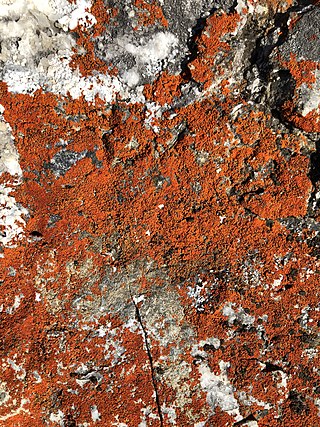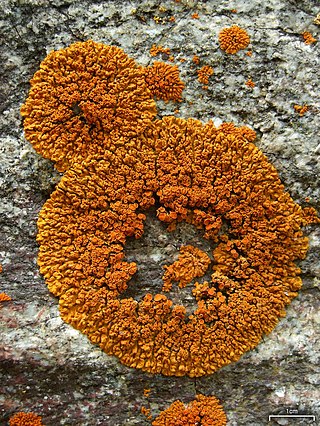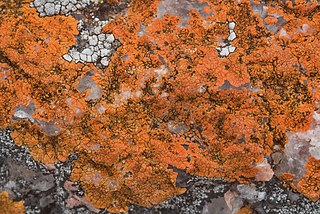
The Teloschistaceae are a large family of mostly lichen-forming fungi belonging to the class Lecanoromycetes in the division Ascomycota. Many members of the Teloschistaceae are readily identifiable by their vibrant orange to yellow hue, a result of its frequent anthraquinone content. The presence of these anthraquinone pigments, which confer protection from ultraviolet light, enabled this group to expand from shaded forest habitats to harsher environmental conditions of sunny and arid ecosystems during the Late Cretaceous. Collectively, the family has a cosmopolitan distribution, although members occur predominantly in subtropical and temperate regions. Although most members either live on rock or on bark, about 40 species are lichenicolous–meaning they live on other lichens.
Neobrownliella brownlieae is a species of saxicolous (rock-dwelling), crustose lichen in the family Teloschistaceae. It is widely distributed in Australia.

Igneoplaca is a genus in the subfamily Xanthorioideae of the family Teloschistaceae. It contains a single species, the crustose lichen Igneoplaca ignea.
Caloplaca wallabyensis is a species of crustose lichen in the family Teloschistaceae. Found in Australia, it was formally described as a new species in 2010 by lichenologists John Alan Elix, Sergey Kondratyuk, and Ingvar Kärnefelt. The type specimen was collected by Elix in Western Australia's Wallaby Hills Nature Reserve, for which the species is named. Here it was found growing on an old termite mound in Eucalyptus salmonophloia woodland with Xanthorrhoea shrubs and laterite rocks. It is known only from the type locality, where it is common.
Kaernefia is a genus of crustose lichens in the family Teloschistaceae. It has three species, found in Australia or South Africa.
Caloplaca kedrovopadensis is a little-known species of crustose lichen in the family Teloschistaceae. It is only found in the Kedrovaya Pad Nature Reserve in the Russian Far East, and on the Jiri Mountain of South Korea. The lichen has been recorded growing on rocks and on bark.
Gallowayella aphrodites is a species of corticolous (bark-dwelling), foliose (leafy) lichen in the family Teloschistaceae. It is found in the Mediterranean countries Greece, Cyprus, and Italy. Characteristics of the lichen include its small thallus, the disposition of the rhizines on the thallus undersurface, and the lack of vegetative propagules.
Neobrownliella is a genus of crustose lichens in the subfamily Teloschistoideae of the family Teloschistaceae. It has five species. The genus was circumscribed in 2015 by lichenologists Sergey Kondratyuk, Jack Elix, Ingvar Kärnefelt, and Arne Thell, with Neobrownliella brownlieae assigned as the type species. It is a segregate of the large genus Caloplaca. Characteristics of Neobrownliella include a thallus that is continuous or areolate, the presence of anthraquinones as lichen products, a cortical layer with a palisade paraplectenchyma, and the lack of a thick palisade cortical layer on the underside of the thalline exciple. Two species were included in the original circumscription of the genus; an additional three species were added in 2020.

Golubkovia is a single-species genus in the family Teloschistaceae. It contains the species Golubkovia trachyphylla, a crustose lichen. The genus was circumscribed in 2014 by Sergey Kondratyuk, Ingvar Kärnefelt, John Elix, Arne Thell, and Jae-Seoun Hur. The generic name honours Russian lichenologist Nina Golubkova (1932–2009), who, according to the authors, "made important contributions to lichenology in northern Eurasia".
Tassiloa is a genus of lichen-forming fungi in the family Teloschistaceae. It has two species.

Fulgogasparrea appressa is a species of saxicolous (rock-dwelling), crustose lichen in the family Teloschistaceae. It has a widespread distribution in western Mexico, including Baja California. It is characterized by its vibrant colors, unique shape, and specific habitat preferences.
Elixjohnia is a genus of lichen-forming fungi in the family Teloschistaceae. It has four species of saxicolous (rock-dwelling), crustose lichens that occur in Australasia.
Sirenophila gintarasii is a species of lichen in the family Teloschistaceae. Found in Australia, it was formally described as a new species in 2009 by lichenologists Sergey Kondratyuk and Ingvar Kärnefelt, as a member of the genus Caloplaca. The type specimen was collected by the authors from the Camel Rock reserve. There it was found growing on coastal rock outcrops, along with the crustose species Sirenophila eos and Dufourea ligulata, some of which had been deformed by the lichenicolous fungus species Arthonia sytnikii and Pyrenidium actinellum. The species epithet honours Tasmanian lichen lichenologist Gintaras Kantvilas. Ulf Arup and colleagues transferred the taxon to the genus Sirenophila in 2013, following a molecular phylogenetics-based restructuring of the family Teloschistaceae. Sirenophila gintarasii occurs in New South Wales and Victoria.
Sirenophila eos is a species of saxicolous (rock-dwelling), crustose lichen in the family Teloschistaceae. It was first formally described as a new species in 2007 by Sergey Kondratyuk and Ingvar Kärnefelt, as Caloplaca eos. The type specimen was collected from rhyolite outcrops in New South Wales. Ulf Arup and colleagues transferred the taxon to the newly circumscribed genus Sirenophila in 2013, following a molecular phylogenetics-based restructuring of the Teloschistaceae.
Xanthoria yorkensis is a species of corticolous (bark-dwelling), crustose lichen in the family Teloschistaceae. Found in South Australia, it was formally described as a new species in 2009 by lichenologists Sergey Kondratyuk and Ingvar Kärnefelt. The type specimen, collected along the Maitland road in Yorke Peninsula, was found growing on Melaleuca trees in mallee scrub. The species epithet refers to its type locality, the only place the lichen is known to occur. Kondratyuk and colleagues proposed to transfer the taxon to the newly circumscribed Jackelixia in 2009, but this genus has not been widely accepted by other authorities.
Xanthoria kangarooensis is a species of corticolous (bark-dwelling), crustose lichen in the family Teloschistaceae. Found in Australia, it was formally described as a new species in 2009 by lichenologists Sergey Kondratyuk and Ingvar Kärnefelt. The type specimen was collected from East Kangaroo Island, where it was found growing on dead Lycium ferocissimum shrubs. Other associated lichens include species of Pyxine, Ramalina, and Rinodina. The species epithet kangarooensis refers to its type locality, the only place the lichen is known to occur. Kondratyuk and colleagues proposed to transfer the taxon to the newly circumscribed Jackelixia in 2009, but this genus has not been widely accepted by other authorities.
Caloplaca aseptatospora is a species of corticolous (bark-dwelling), crustose lichen in the family Teloschistaceae. Found in Australia, it was formally described as a new species in 2009 by lichenologists Sergey Kondratyuk and Ingvar Kärnefelt. The type specimen, collected from Coochiemudlo Island in 1982 by Rex Filson, was found growing on the base of a sheltered tree trunk. The species epithet alludes to its main diagnostic character–largely immature, non-septate spores. Caloplaca aseptatospora is only known to occur in a few localities in Queensland.
Caloplaca begaensis is a species of terricolous (ground-dwelling), crustose lichen in the family Teloschistaceae. Found in New South Wales, Australia, it was formally described as a new species in 2009 by lichenologists Sergey Kondratyuk and Ingvar Kärnefelt. The type specimen was collected by the first author from the Bega Valley Shire, at Beares Beach, where it was found growing on soil near sandstone outcrops. The species epithet refers to the type locality, the only place the lichen has been documented.
Cerothallia yarraensis is a species of corticolous (bark-dwelling), crustose lichen in the family Teloschistaceae. Found in Australia, it was formally described as a new species in 2009 by lichenologists Sergey Kondratyuk and Ingvar Kärnefelt, as Caloplaca yarraensis. Kondratyuk and colleagues transferred it to the genus Cerothallia in 2014.

Erichansenia is a genus of lichen-forming fungi in the family Teloschistaceae. It has three species of saxicolous (rock-dwelling), crustose lichens.




